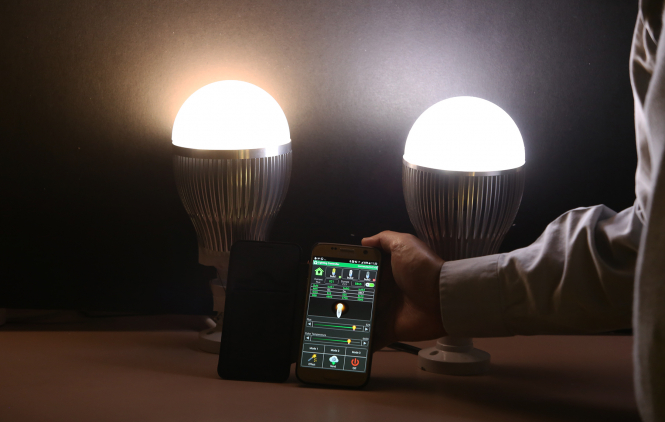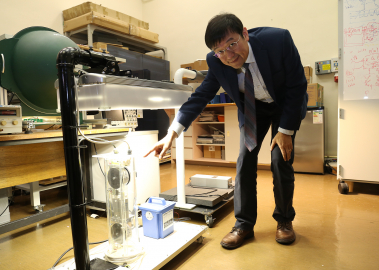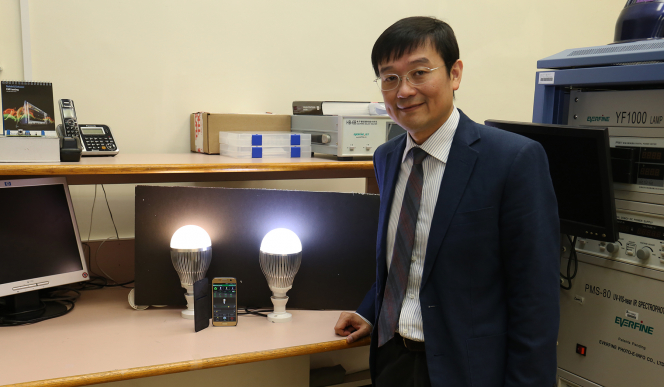Media
HKU Chair of Power Electronics Professor Ron Hui led sustainable lighting systems research brings new LED products and theory breakthrough
07 Dec 2017

A smart system for precise dimming and colour control of LED lamps comprising warm-white and cool-white colour
The project led by Professor Ron S.Y. Hui, Chair of Power Electronics at the Faculty of Engineering of the University of Hong Kong on sustainable lighting systems has led to both theoretical and practical breakthroughs. Novel LED systems with not only high energy efficiency and luminous efficacy, but also lifetime exceeding 10 years and over 80% product materials recyclable have been studied and developed.
The project was funded by the Research Grants Council’s Theme-based Research Scheme (TRS) (Second round).

A LED lighting system which meets all three criteria of sustainability: energy saving, long product lifetime and recyclability of product materials
Passive LED drivers developed under the project were tested in Heshan City, Guangdong in over 100 street lamps. Zero failure rate was recorded for a three-year trial period. This has been the world’s first and only “sustainable LED street lighting system” that meets the three sustainability criteria of high energy efficiency, long product lifetime and recyclability. The team is planning to extend the system to cover over 8,000 street lamps in the Mainland. .
The research team stresses that sustainable lighting technology should incorporate a new principle that includes (i) energy saving, (ii) long product lifetime and (iii) recyclability of product materials. It highlights the important point that “energy-saving technology is not necessarily environmentally-friendly if it generates lots of harmful electronic waste within a short product lifetime”. The idea deviates from the traditional Energy-Star concept which focuses on energy saving only.
The project has been visible internationally, with 27 journal papers with collaborators either published or already accepted. Among them 20 appeared in the field’s top academic journal IEEE Transactions on Power Electronics. A total of 11 patent applications have been filed.

Professor Ron Hui's research team achieves major breakthrough both in ttheory and technology developing a smart system for precise dimming and colour control of LED lamps
The team’s latest innovation is a smart system for precise dimming and colour control of bicolour adjustable LED lamps comprising warm-white and cool-white colour, which is a major breakthrough both in technology and theory. In addition, the research team has classified all LED driver topologies and their suitability for various applications. This classification provides a guideline for lighting industry to select the appropriate topologies for their products. New LED structures with new features have also been studied. New approaches to highly efficient LED panel display and current-balancing technologies have been successfully developed. A group of high-quality research students in LED technology have been trained. In addition, several patent-pending technologies have been transferred to industry for production. The outcomes of this TRS project are expected to be beneficial to thousands of LED companies in South China, Hong Kong and the nearby region.
Project summary
- Development of the Photo-Electro-Thermal Theory for LED Systems for a general analysis and design tool
- Classifications of LED drivers topologies LED
- Development of Sustainable LED systems without electrolytic capacitors
- High-efficiency LED display and current-balancing technology
- Technology transfer of several patent-pending technologies
The project is related to the “sustainability” of lighting systems (used in buildings and cities’ large-scale infrastructures such as road lighting) that consume 20% of electricity globally. Sustainable Lighting Technology proposed here deviates from the traditional Energy-Star concept which focuses on energy saving. It stresses a new principle that includes (i) energy saving, (ii) long product lifetime and (iii) recyclability of product materials. It highlights the important point that “energy-saving technology is not necessarily environmentally-friendly if it generates lots of harmful electronic waste within a short product lifetime”.
This project involves a new investigation into a new General LED System Theory for “multiple non-identical” Solid-State LED devices. By linking LED “device” theory to “system” theory, novel LED systems with not only high energy efficiency and luminous efficacy, but also lifetime exceeding 10 years and over 80% product materials recyclable have been studied and developed. The project focuses on an “integrated system approach” that covers (i) new white LED device structures and manufacturing processes, (ii) novel passive and active LED drivers and control techniques including both power and color control, and (iii) current balancing techniques so that future LED systems can meet the three sustainability criteria.
This project has successfully led to both theoretical & practical breakthroughs. The outcomes of this project include (1) a novel Generalized LED System Theory for “multiple non-identical” LED devices, (2) new LED device structures with improved thermal management, (3) the generalization and classification of LED driver topologies with long lifetime, (4) a new design methodology & tool for optimization of a new generation of highly efficient and sustainable lighting systems, and (5) practical realization of the new “Sustainable Lighting” principle that can replace traditional “Energy-Star” concept with the aim of drastically reducing electronic waste worldwide.
With several major lighting research centres already based in Hong Kong and over 1,000 LED product manufacturers in South China, this project will bring significant benefits to Hong Kong and its nearby regions. Besides the potential contributions made to industry, this project will involve training of research students.
Research impact
This project has successfully led to both theoretical and practical breakthroughs. The team has successfully developed the Photo-Electro-Thermal Theory for LED Systems (Photo-dectro-thermal Theory for LED System: Theory and Applications, Cambridge University Press, Sept 2017). This is the world’s first LED System Theory unifying the interactions of heat, light, electric power and color in one mathematical framework and can now be used by lighting industry as a general design tool for LED systems and products. We have classified all LED driver topologies and their suitability for various applications. This classification provides a guideline for lighting industry to select the appropriate topologies for their products. New LED structures with new features have also been studied. New approaches to highly efficient LED panel display and current-balancing technologies have been successfully developed. A group of high-quality research students in LED technology have been trained. In addition, we have published many influential papers in top-tier journals and have several patent-pending technologies transferred to industry for production. Installations of these new sustainable LED products have been made in China and Hong Kong for over 3 years. The outcomes of this TRS project are expected to be beneficial to thousands of LED companies in South China, Hong Kong and the nearby region.
For media enquiries, please contact Ms Melanie Wan, Communications and Public Affairs Office, HKU, tel: (852) 2859 2600/ email: melwkwan@hku.hk.
